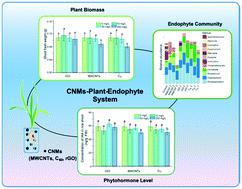当前位置:
X-MOL 学术
›
Environ. Sci.: Nano
›
论文详情
Our official English website, www.x-mol.net, welcomes your
feedback! (Note: you will need to create a separate account there.)
Carbon-based nanomaterials alter the composition of the fungal endophyte community in rice (Oryza sativa L.)
Environmental Science: Nano ( IF 5.8 ) Pub Date : 2020-05-20 , DOI: 10.1039/c9en01400d Yi Hao 1, 2, 3, 4, 5 , Chuanxin Ma 6, 7, 8, 9 , Jason C. White 6, 7, 8, 9 , Muhammad Adeel 1, 2, 3, 4, 5 , Ruohan Jiang 1, 2, 3, 4, 5 , Ziqian Zhao 1, 2, 3, 4, 5 , Yuhang Rao 1, 2, 3, 4, 5 , Guangcai Chen 5, 10, 11, 12 , Yukui Rui 1, 2, 3, 4, 5 , Baoshan Xing 9, 13, 14, 15
Environmental Science: Nano ( IF 5.8 ) Pub Date : 2020-05-20 , DOI: 10.1039/c9en01400d Yi Hao 1, 2, 3, 4, 5 , Chuanxin Ma 6, 7, 8, 9 , Jason C. White 6, 7, 8, 9 , Muhammad Adeel 1, 2, 3, 4, 5 , Ruohan Jiang 1, 2, 3, 4, 5 , Ziqian Zhao 1, 2, 3, 4, 5 , Yuhang Rao 1, 2, 3, 4, 5 , Guangcai Chen 5, 10, 11, 12 , Yukui Rui 1, 2, 3, 4, 5 , Baoshan Xing 9, 13, 14, 15
Affiliation

|
Rice seedlings were exposed to different types of carbon-based nanomaterials (CNMs), including reduced graphene oxide (rGO), multi-walled carbon nanotubes (MWCNTs), and fullerene (C60), at 10–250 mg L−1 under hydroponic conditions for 20 days to investigate the impact of CMN exposure on the composition of the rice endophyte community. Physiological results demonstrated that exposure 10 and 50 mg L−1 MWCNTs and C60 had no overt effect on plant growth; however, at 250 mg L−1 the fresh biomass was reduced by 17.9–23.7% as compared to the control. Conversely, the addition of 50 and 250 mg L−1 rGO increased rice biomass. Exposure to 250 mg L−1 MWCNTs and C60 resulted in approximately 20–40% decrease in the content of three endogenous phytohormones, including indole-3-acetic acid (IAA), zeatin riboside (ZR), and gibberellic acid3 (GA3). A high-throughput sequencing technique was used to analyze the composition of the fungal endophyte community as affected by CNMs exposure. The results suggest that fungal endophytes in rice were sensitive to CNM exposure even at 10 mg L−1 CNM exposures; the community composition at different levels (phylum, class, and genus) in the 250 mg L−1 MWCNTs and C60 treatments were significantly altered as compared to the control. Taken together, the present work provides new insight on the potential consequences of NM exposure on terrestrial plants. Additionally, it is clear that a systematic evaluation of the risks of CNMs to commensal species such as endophytic fungi is necessary to fully understood the risk these materials posed in the environment.
中文翻译:

碳基纳米材料改变水稻(Oryza sativa L.)中真菌内生菌群落的组成。
水稻幼苗在水培条件下以10–250 mg L -1暴露于不同类型的碳基纳米材料(CNM),包括氧化石墨烯(rGO),多壁碳纳米管(MWCNT)和富勒烯(C 60)。20天的条件以调查CMN暴露对水稻内生菌群落组成的影响。生理结果表明,暴露于10和50 mg L -1 MWCNT和C 60对植物生长没有明显影响。然而,与对照相比,在250 mg L -1时,新鲜生物量减少了17.9-23.7%。相反,添加50和250 mg L -1 rGO可增加稻米的生物量。暴露于250 mg L -1 MWCNT和C60导致三种内源性植物激素的含量降低了约20–40%,其中包括吲哚-3-乙酸(IAA),玉米蛋白核糖苷(ZR)和赤霉素3(GA3)。使用高通量测序技术来分析受CNM暴露影响的真菌内生菌群落组成。结果表明,即使在10 mg L -1 CNM暴露下,水稻中的真菌内生菌也对CNM暴露敏感。250 mg L -1 MWCNT和C 60中不同水平(种群,类别和属)的群落组成与对照相比,治疗有显着改变。综上所述,本工作为NM暴露对陆生植物的潜在后果提供了新的见解。此外,很明显,有必要对CNM对常见物种(例如内生真菌)的风险进行系统评估,以充分了解这些物质对环境造成的风险。
更新日期:2020-07-16
中文翻译:

碳基纳米材料改变水稻(Oryza sativa L.)中真菌内生菌群落的组成。
水稻幼苗在水培条件下以10–250 mg L -1暴露于不同类型的碳基纳米材料(CNM),包括氧化石墨烯(rGO),多壁碳纳米管(MWCNT)和富勒烯(C 60)。20天的条件以调查CMN暴露对水稻内生菌群落组成的影响。生理结果表明,暴露于10和50 mg L -1 MWCNT和C 60对植物生长没有明显影响。然而,与对照相比,在250 mg L -1时,新鲜生物量减少了17.9-23.7%。相反,添加50和250 mg L -1 rGO可增加稻米的生物量。暴露于250 mg L -1 MWCNT和C60导致三种内源性植物激素的含量降低了约20–40%,其中包括吲哚-3-乙酸(IAA),玉米蛋白核糖苷(ZR)和赤霉素3(GA3)。使用高通量测序技术来分析受CNM暴露影响的真菌内生菌群落组成。结果表明,即使在10 mg L -1 CNM暴露下,水稻中的真菌内生菌也对CNM暴露敏感。250 mg L -1 MWCNT和C 60中不同水平(种群,类别和属)的群落组成与对照相比,治疗有显着改变。综上所述,本工作为NM暴露对陆生植物的潜在后果提供了新的见解。此外,很明显,有必要对CNM对常见物种(例如内生真菌)的风险进行系统评估,以充分了解这些物质对环境造成的风险。











































 京公网安备 11010802027423号
京公网安备 11010802027423号